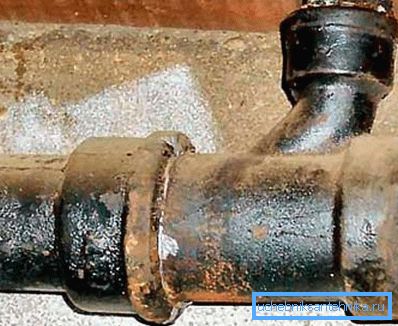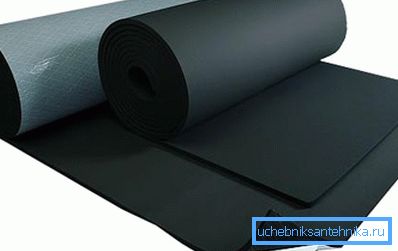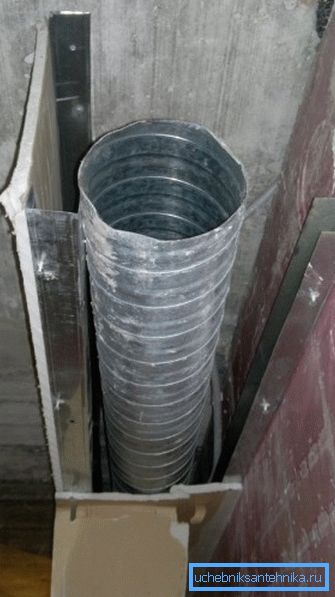Noise isolation pipes sewage - consider all the nuances of
Today there is a great demand for such an operation as sound insulation of sewage pipes in an apartment. With the use of plastic products, the need for such a procedure began to appear, so we will tell you about it in detail below.

Theoretical information
To feel confident during the execution of a procedure, a person needs to stock up on a substantial amount of theoretical knowledge. We understand this, so we will give you a generous piece of information.
Where the noise comes from
Surely many people will ask such a question. In general, the noise is produced by the entire structure, which arises from the movement of sewage.
It can appear for the following reasons:
- Water speed too high.
- Poor attachment of system elements.
- The cross-section decreases as a result of the formation of various deposits.
Tip: in order to avoid deposits, regularly use a means to eliminate blockages.
- Any defects in the highway.
- Leak through taps.

- The contents of the riser beats on the wall.
- Transmitted vibrations of the building.
- If the system is brought outside, then one of the reasons may be wind.
As you can see, there are a lot of reasons. In this regard, the insulation of plastic sewer pipes is a very urgent task.
The appearance of noise is influenced by various factors:
- Wall thickness. Remember a simple dependency: the thinner the pipe, the more it “noise”.
- Location. Best of all, during the construction phase to provide this factor. In particular, it is best to place the highway as far as possible from the walls.
- Seal type. Often, builders use a simple foam assembly, which is not characterized by high noise absorbing properties.
- Material. So, the most noise has ordinary plastic. In turn, the cast iron is completely "silent".
Why the iron does not make noise
Surely, many will ask such a question.
The thing is this:

- Cast iron is a eutectic alloy. Simply put, it is a cluster of various microscopic "grains", different in composition. As a result, these “grains”, as a result of mechanical influences, seem to rub against each other, and this naturally absorbs all the vibrations.
- It is also important that over time cast iron acquires a certain bloom, which is also capable of damping vibrations.
After learning this information, you might think that using cast iron for sewage is an excellent option. However, it is worth noting that it is fragile, heavy and not aesthetic. In addition, today the price of products from a different type of plastic has become available to everyone.
Analyzing materials
Today, there are many different materials that allow to produce high-quality sound insulation.
We will look at some of the most popular ones:

- Mineral wool. It is a refractory material (maximum operating temperature - 750 degrees). For this reason, it is often used to make insulation of the heating pipe.
- Fiberglass - used primarily for outdoor use.
Note! When using fiberglass, be sure to use protective equipment, because it causes irritation of the skin and, especially, do not allow it to get into the eyes.
- Polyethylene - a versatile material with which you can carry out any installation work.
- Synthetic rubber is an excellent solution for working at extremely low temperatures. Has full tightness, thanks to a strong seam. Perhaps the most perfect sample in this area.
- Drywall In particular, we are talking about creating a small box. On the construction of such a structure, we will talk further.
Take the utmost attention to the choice, because much will depend on it.

Installation Tips
Our instructions will consider a very efficient method of dealing with extraneous noises - the creation of a box of plasterboard. Implement such a project is not difficult, the main thing is to show maximum effort and endurance.
Preparation of tools
First of all you need to prepare the following list of equipment:
- Level (better laser, because it provides perfect accuracy).
- Screws for metal.
- Pencil and ruler.
- Dowel.
- Drywall It is advisable to purchase a moisture-resistant counterpart, because only he can stand for a long time.
- Square.
- Ceiling profile (its length should be leveled to the ceiling height).
- Start profile.
- Mineral wool.
- Jumper CD 60.
Main scope of work
If you have never done such operations with your own hands, you probably want to get detailed and clear explanations.
Therefore, we will present the entire scope of work concisely and consistently:
- First of all, we prepare the pipes themselves: priming, painting, checking the integrity. Such a measure is needed to avoid problems in the future.

- Next, we start creating the box. To do this, we apply the markup using the level, retreating from the pipe by a few centimeters.
- We mount the first profile to the wall using dowels (if the wall is concrete or brick) or screws (if wooden). In the same way, we fix the second profile on the opposite wall.
- With the help of the square we apply the lines perpendicular to the established profiles on the floor and the flow. At the point of intersection put a label that will be a guide for the installation of the last profile.
- On the floor on the applied marking we fix the start profiles with the help of self-tapping screws.
- At the intersection fix the third profile. The resulting frame is fixed with screws. On this construction we install jumpers every 40-45 cm.
- Now fasten drywall. It is advisable to leave a small hatch (maybe even a few), which will allow inspecting the pipes and, if necessary, repair.

- When one side of the box is complete, we lay inside the mineral wool. It is necessary to fill the entire space.
- After that we sew the second side. In the end, it is desirable to coat the drywall with some kind of paint and varnish to increase its lifespan.
This is just one of the possible options. It is the “duet” of drywall box and wool that provides maximum protection against extraneous noise.
Alternative option
If you do not want to mess with this design, then you can do it easier - to sheathe the pipes with a noise insulator. So, you will need: well-ground scissors, vibration damping material, some sound attenuator with an adhesive base (for example, polyethylene foam), a roller.
Works are performed in the following sequence:
- We degrease the surface (White spirit will do).
- Over the entire area we glue the vibration-damping material. Its purpose is to neutralize structural noise that penetrates the surface.

- Now it is necessary to make his stitching using a special roller. This should be done carefully in order to remove all air bubbles.
- In the end we put the chosen noise attenuator.
This work is completed.
In conclusion
On such a positive note, we will complete our story, but you can get a more complete range of knowledge. In the presented video in this article you will find additional information on this topic. Viewing it will help you understand all the details.